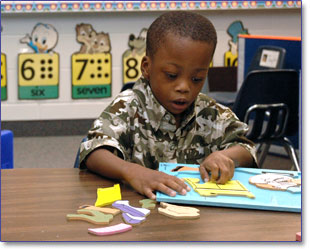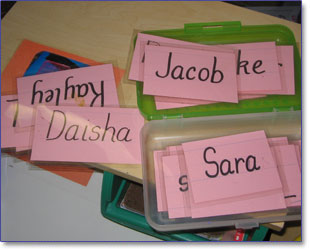  (Page 1 of 3) (Page 1 of 3)
ABC Songs and Beyond
 Your goal is to help children learn
to recognize and name individual letters. While
learning to sing or chant an alphabet song is
not sufficient for developing this skill, it is
an important first step. Teaching children an
alphabet song or chant familiarizes them with
the names of the letters. Their familiarity with
letter names will support children as they learn
to recognize and name individual letters. Your goal is to help children learn
to recognize and name individual letters. While
learning to sing or chant an alphabet song is
not sufficient for developing this skill, it is
an important first step. Teaching children an
alphabet song or chant familiarizes them with
the names of the letters. Their familiarity with
letter names will support children as they learn
to recognize and name individual letters.
There are many different alphabet songs and chants to choose from. It helps to choose one song or chant to use on a daily basis. It is also fun to include other popular alphabet songs and chants for variety every now and then. Try to choose an alphabet song or chant that helps children distinguish the names of each letter. Try to choose an alphabet song or chant that breaks the chant between L, M, N, O, and P rather than running these letter names together. Singing or chanting an alphabet song and playing alphabet games can be easily incorporated into your daily circle time.
Keep in mind that in adddition
to having children singing and chanting the
names of letters, you will need to plan a sequence
for introducing and teaching children how to
identify each letter of the alphabet. Your instructional
goal is to help children make distinctions among
letters—to help them see the details in
how marks and shapes come together to form
a specific letter. There are a few basic shapes
that are used to form just about every letter.
These include sticks, curves, circles, slants,
tails, and tunnels. You can help children categorize
letters by these features as they learn them.
You may want to create games and activities
where children organize a pile of alphabet letters
into these groups. During these activities you
should help children focus on noticing specific
features of each letter (sticks, curves, circles,
slants, tails, tunnels) rather than naming letters.
Keep in mind that as you systematically introduce
and teach the names of the letters, you may not
want to introduce letters that share the same
features all at once. Rather, you may want to
organize the order in which you introduce letters
to emphasize contrasting features.
You will want to keep track of children’s
progress in recognizing and naming individual
letters during the year. You may notice some children
having a difficult time remembering the names
of letters you have introduced and taught to the
class. Be sure to provide additional practice
opportunities for these students. As you work
with your students during the year, you may also
notice that they learn to recognize and name uppercase
letters more readily than lowercase letters. It
is much easier to distinguish the differences
among uppercase letters than lowercase letters.
However, by the end of the year, you want your
students also to be able to recognize and name
some lowercase letters. Lowercase letter recognition
is essential to reading, because most of the letters
we encounter in text are lowercase letters.
Using Children’s Names
 The
most important word to any child is his or her
name. Using children’s names
to introduce and teach the letters of the alphabet
is a great place to start. It’s a good idea
to have many models of children’s names
in the classroom. For example, have the class
roll on your classroom door, label students'
cubbies with their names, and have a
class job list that includes each child’s
name. Play games or sing songs with
your students’ names. The
most important word to any child is his or her
name. Using children’s names
to introduce and teach the letters of the alphabet
is a great place to start. It’s a good idea
to have many models of children’s names
in the classroom. For example, have the class
roll on your classroom door, label students'
cubbies with their names, and have a
class job list that includes each child’s
name. Play games or sing songs with
your students’ names.
As children become familiar with the letters in their names, they may also start to pay attention to the letters in their friends’ names or to the letters in other words that are important to them. Use these important words as anchors to help children remember the names and shapes of the letters.
|